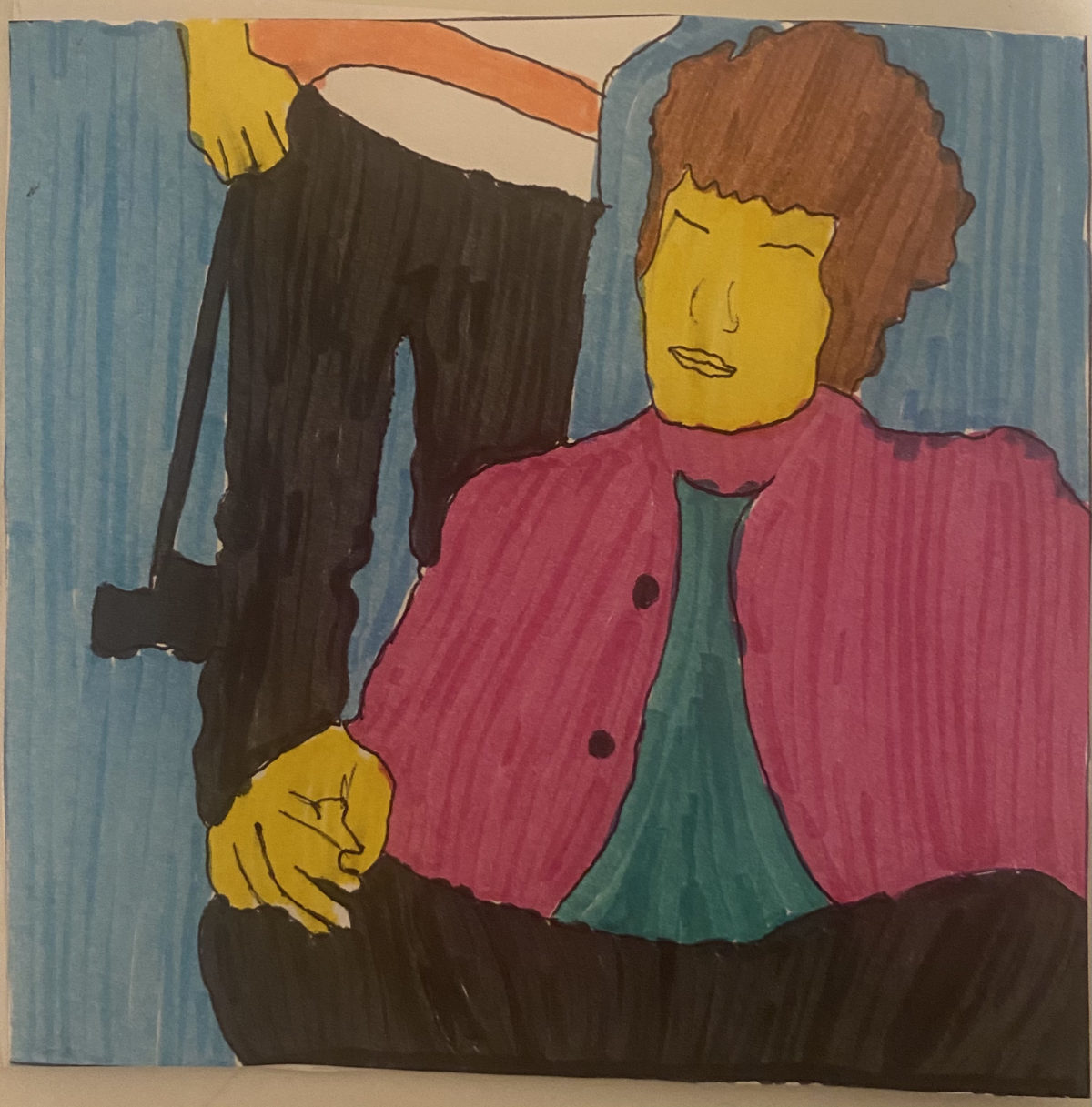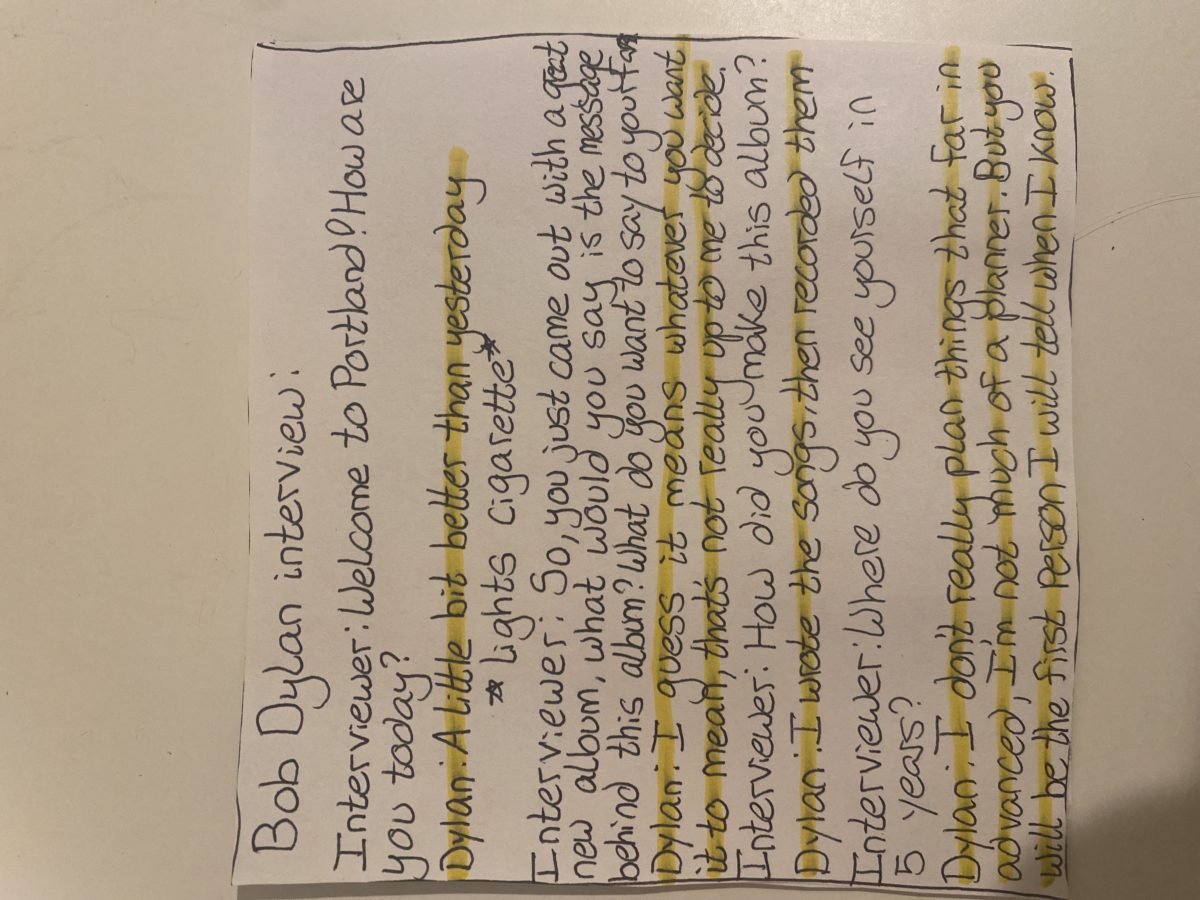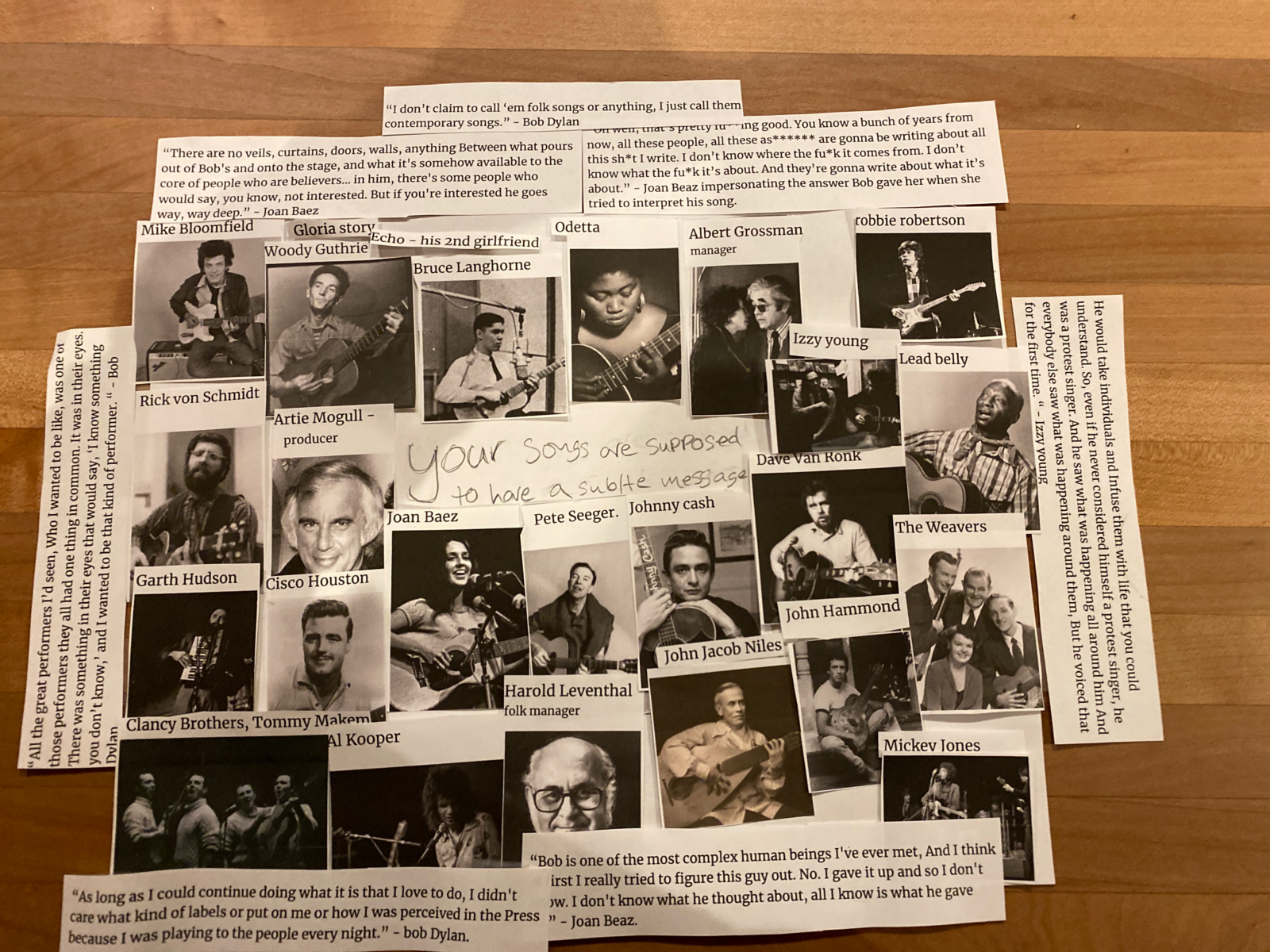The History and Popular Music of the ’60s class learned about a pair of classic Bob Dylan albums, Highway 61 Revisited (1965) and Blonde on Blonde (1966). Here are their reactions.
Pritam Khalsa:
In the early to mid 1960s Bob Dylan was unofficially named the face of folk music of that generation. His bizarre lyrics and catchy music were very appealing to young people. He did not write the traditional type of songs at the time which consisted mainly of love songs. His fans kind of expected him to stay this young folksy weirdo who went against societal norms without understanding that musicians write music for themselves, not just their fans. As he grew as an artist, his style started to change and he played some electric songs. When Highway 61 Revisited and Blonde on Blonde were released and he was playing more and more electric songs which people interpreted as him selling out. Fans continued to get annoyed and angry at his concerts and complain when he wouldn’t play acoustic songs. Reporters would also ask him very specific questions about the meaning behind his songs and would continue to pester him if he didn’t have an answer. They would also ask what he thought about being the spokesperson of that generation and he didn’t agree with them calling him that. I feel like he was slightly contradictory because when he was younger he seemed to like the idea of becoming a famous musician but he didn’t really understand what that would mean. Once he became famous, he appeared to be more interested in the music than the fame. Dylan most likely had a naïve concept of fame and he seemed more wrapped up in travelling around and making music than visiting with fans and talking to journalists.
My favorite two songs from Highway 61 Revisited are “Tombstone Blues” and “Ballad of a Thin Man,” and “Stuck Inside of Mobile with the Memphis Blues Again” and “Leopard-Skin Pill-Box Hat” from Blonde on Blonde. “Tombstone Blues” is very fast-paced with an electric guitar and a very catchy chorus. It’s one of the longer songs on the album however but it doesn’t feel too long or repetitive. “Ballad of a Thin Man” is also rather long but it is more slowly paced. It’s also formatted differently than a lot of songs. Instead of the more traditional verse, chorus, verse, chorus, etc, with maybe a bridge as well, “Ballad of a Thin Man” is just verses with “Do you, Mr. Jones?” at the end of each of them. “Stuck Inside of Mobile with the Memphis Blues Again” has a harmonica in parts of it. It’s somewhat repetitive but the repetitive parts are shorter so it doesn’t feel too repetitive. It’s not super fast but it’s faster than “Ballad of a Thin Man” and more bright sounding. “Leopard-Skin Pill-Box Hat” is shorter than the other three songs. It’s similarly paced to “Stuck Inside of Mobile with the Memphis Blues Again” although it’s a little faster sounding. It sounds bright still, but also a little darker sounding.
Lily Brooks:
I decided to draw the cover of Highway 61 Revisited and write my own Bob Dylan interview. I drew this album cover because it was my favorite of the two, and I like the photo a little better. I did it in a color block design because I think it made it pop more! On the back side of it I wrote an interview in ways that I think Dylan would’ve responded. I loved watching his interviews in the documentaries because not only were they funny, but it was interesting to see him annoy the reporters as much as they were annoying him. I also think watching his interviews gives a quick glimpse of to who Bob Dylan was in his younger years: funny, outspoken, etc.
Alex Skiles:
I wrote a quick Dylan lyric generator. First, I went through both albums, making an array of every weird person I could find (about 70), and did the same for absurd actions (about 60). Then, I wrote a javaScript program that randomly splices these together, with an end result of making some random lyrics that are awkward and clunky, and others that could totally be in a Dylan song. I guess my point in doing this was that while I like the absurd elements of some of his songs, sometimes it feels like absurdity for absurdity’s sake, and you could just swap any verb or noun with another and it wouldn’t really change the content of the song. Or maybe I just don’t get the references.
Gibson McCoy:
For my project, I compiled different artists that have inspired Bob Dylan and who helped him create a music style into one collage. Sometimes there are so many artists that inspire you to do what you love, that you try to make it all into one style. Sometimes this thing works, and for Bob Dylan it did. It gave him a unique style of playing. He would play the guitar and harmonica at the same time, which are two different common instruments played in folk music. He would use his poetry and create lyrics. But sometimes these lyrics were not understandable to people listening. There is a three-hour long documentary called No Direction Home, which focuses on Dylan and includes interviews with several other artists. There are also press interviews of him when he was younger. In the interviews, there is often one question that is asked. That question is “does your music have a message?” Not all of the interviewers ask the question in the same words but that’s more or less what they mean. Most of the time he never answers the question and other times he asks the reporters question another question for them to answer. For this question, you almost have to look back at all the people that inspired him to get your answer. Throughout this movie, I took notes and wrote down quotes that I think are essential to think about when you’re trying to find meaning in his songs. The quotes around the edges of the paper are there to show that even Dylan admits that sometimes he doesn’t know why he writes certain things. This mystery of why he writes certain songs is what most people find most intriguing about him.
Sam Swartley:
Bob Dylan: Then, After, and Now
“Shy Dylan Rock Fan” (Original)
You find yourself in an over packed venue, the energy never ceases to amaze you. Waiting in the line that goes around the block in the cold night air, walking through the doors and feeling the rush of heat, excitement and cigarette smoke. Somehow working your way up to around three people away from the stage, you can see the guitars and amps laying on stage waiting to fill the room with warm soothing textures. The lights shut off. The entire crowd erupts in booing. A spotlight flickers on behind you, illuminating the band. The guitars and symbols shimmer through the thick smoke that has now settled over the crowd. Everyone around you is booing at the top of their lungs, while you and a select few are cheering. Even if you’re booing or cheering it’s impossible for you not to feel the excitement that Dylan fills you with. As the black Telecaster’s sweet tone rings out Dylan speaks into the mic “I don’t believe you… you’re a liar!” as a response to the booing, because he thinks his music is great. He turns to the band and yells “play f**cking loud!” as they launch into “Like a Rolling Stone.” The feeling of Dylan’s band is indescribable, the joy and humor they all convey while playing and creating this beautiful music is like a dream.
Then (Don’t Think Twice, It’s All Right)
Bob Dylan’s story of how everything started could have happened one way or another, Dylan’s life story doesn’t define his music in the way you might think (partially because some of it is possibly not true). I believe that his life experiences define how he views the world, not necessarily true lived experiences. Dylan’s career started with a solo guitar set, which was raw and beautiful, and shows the power of music and a single man with a guitar. As someone who mainly listens to jazz, Dylan’s earlier music was a whole new world to me. You can feel these emotions not because of the Dominant 7 b5 #9 chord, but because of what you can relate to within his words. Dylan puts the listener in a place that can relate to what he is saying (or as much as you can understand) that allows you to connect your brain to his words and ideas. He loved playing, performing, and creating music. Just about everyone knew the name Bob Dylan. Within the music industry he started to take off, and forever changed how Dylan would live his life.
After (Like a Rolling Stone)
In 1965 Dylan changed his sound, more towards the rock side of things. This put Dylan’s whole vibe in a different place. His hardcore folk fans hated it, and let Dylan now that he should go back to his orginal sound (hence the booing). I think Dylan as an artist changing and evolving his sound was a strong important decision, allowing him to go anywhere he wanted with music as a whole. Comparing this to something a little more jazzy: Miles Davis in 1970 went from standard cool jazz to a fusion sound, giving him no limits to what he could do with music. Dylan did the same thing, not necessarily caring about his audience, because he didn’t care what they thought, if they wanted to listen they could. Dylan was writing the music he wanted whether it was rock, folk, or blues it all didn’t matter. I think making it more inspiring and overall moving his music forward creatively. I think this is necessary for artists to evolve and grow as a human. All that being said the reason Dylan’s sound change wasn’t accepted was because what he originally did was so powerful and was something people could call home. Switching it up was like moving into an apartment from a mansion. People don’t like change, even me, but I think getting used to it and learning how to accept change is a powerful life tool that you can learn from Bob Dylan.
Now (Key West)
“What are you saying in your songs?” Dylan got asked a lot. This is what I really love about Bob Dylan, the way he views his own music and how he explains this to the press or whoever is asking. He answers this question with another question, “What do you think it means?” That is the answer. Anyone can enjoy and understand the music anyway they want, Dylan doesn’t know what it is, just you (the listener) does. You can compare this to his first albums or the album he dropped this year. Dylan believes that listening to music is all about how you perceive it, of course he was always talking about his music but it relates to anything anyone ever listens to. The way I emotionally connect with A Love Supreme by John Coltrane is always gonna be different than someone else, but there is this grey area that me, other listeners and Coltrane can relate and agree on. This is what makes Dylan’s music so powerful, the vibe he produces allows everyone to connect with and relate to, but in their own personal way.







